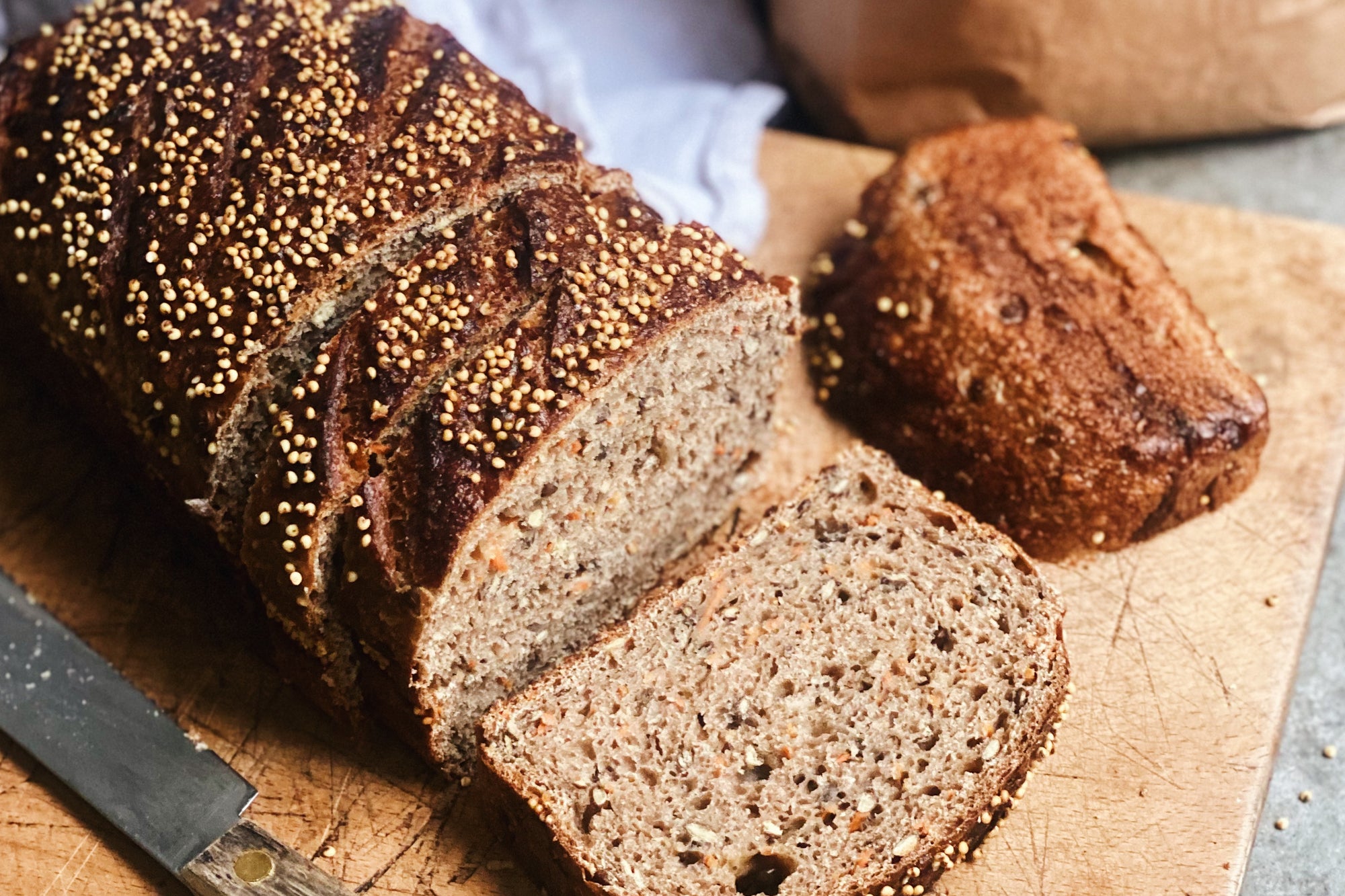This rustic and comforting whole grain loaf was developed by the bakers at our bakery! You can interchange the lentils for other legumes and the carrot can be swapped out for any other root veggies. Any leftover lentil mix is great in soup or topped on a salad. This recipe makes one loaf.
Carrot + Lentil Spelt Sourdough
~ recipe by Cheryl O'Shea
Dough
325g Flourist Whole Grain Spelt Flour
260g Water
55g Starter
8g Salt
70g Shredded Carrot
130g Lentil Mix
1/2 tsp Dill Seed
1/2 tsp Caraway Seed
Lentil Mix
1 Bay Leaf
40g Dry Lentil
32g Shallot
1 Clove Garlic
1/2 tsp Salt
1/4 tsp White or Black Pepper
Prepare the lentil mix. Cover lentils and bay leaf with water, boil until tender. Drain. Sauté shallot and garlic, add cooked lentils and let cool.
Autolyse
Add the water and starter, followed by the flour to a large mixing bowl (using the tare function on your scale as you go). Mix by hand until there are no dry spots and a shaggy dough is formed. Let the dough rest in a warm place for 30 minutes covered with a tea towel. This stage is called the autolyse.
Add Salt
Next, add the salt to your dough. Wet your hands and squeeze the dough to incorporate it into your dough.
First Fold
Once combined, transfer your dough to a new bowl that is lightly oiled and perform your first fold by grasping the top of the dough, stretching it until there is resistance, and folding it onto itself towards the bottom. Do the same from bottom to top, and side to side. You want to fold until you feel resistance from the dough and it feels nice and tight. Flip the dough over and let sit again, covered with a tea towel, for 30 minutes.
Bulk Fermentation
Repeat this folding process 5 more times for a total of 5 folds with 30 minutes of rest time between each fold. This is called the bulk fermentation stage and is 2.5 hours total for the bulk fermentation.
Before you perform the third fold add the grated carrot, lentil mix, dill and caraway seeds and squeeze into the dough the same way you added the salt. Do not worry if they are not very evenly distributed as the next folds will mix them in even further.
Pre-shape & Bench Rest
After the last fold and final 30 minute rest, invert the dough onto the counter.
To pre-shape, round the dough in on itself by rotating the portioned dough with a bench scraper and your hand. The loaf should feel taut on the surface but not tear. If you see any tearing of the loaf immediately stop shaping. Lightly dust the top with flour and let sit, uncovered, for another 20-30 minutes. This is called the bench rest.
Final Shape & Bake
Begin by spraying or oiling your loaf pan. Then, flip the pre-shaped round over and fold the top in towards the middle, pressing down slightly. Do the same with the bottom. Rotate 180° and grab the top and bring down again towards the middle. Roll it in on itself until you reach the end, pressing down slightly to create a seam. Transfer, seam side down, into the loaf pan. Brush with water and add some millet to the top of the loaves. Cover with plastic wrap and refrigerate overnight.
Baking
Pull bread from the fridge and proof at room temperature for 1-2 hours. Check to see if your bread is proofed by pressing a lightly floured finger into the dough. When you remove your finger the indentation you made should remain and only very slightly spring back. Once you reach this stage preheat your oven to 450°F. Set up your racks with one in the middle of the oven and one underneath. Fill a shallow cake pan (you want one that is shallow enough to fit on the bottom rack) with about an inch of water and slide in between the two racks to sit on the bottom rack.
Lightly score the loaf (this is optional but your bread may naturally crack open if you do not score), and place on the middle rack. Lower the oven to 425°F and bake for 30 minutes.
After the 30 minutes, very carefully remove the cake pan with water from the oven. Bake for an additional 15-20 minutes, until a thermometer inserted into the middle of the loaf reads 200°F. Remove from the oven and immediately invert out onto a wire rack to cool.
This recipe may take some tweaking in terms of baking times and temperatures. We found when testing that each of our ovens had a slightly different bake. It is important to check the temperature throughout your bake as this is the most reliable way to ensure that your loaf is fully baked. We do not recommend trying this recipe without a thermometer.
Note: This recipe was created by our bakers and is tested for use with our freshly milled flour.



Comments
OMG this bread is delicious! I used grated sweet potatoes and beluga lentils. Up there with one of the most interesting sourdough breads I have made. Thanks for the recipe!
Very tasty! I did have issues with the loaf getting super stuck in my loaf pans despite over-oiling when I put the loaves in to rise which was a real bummer when I tried to turn them out and lost the bottoms. I also found that I needed to bake much longer than suggested in the recipe to reach 200 degrees.
As soon as I read this recipe this morning, I knew this is the next loaf I am baking. I can almost taste how wonderful it will be.
Thanks for creating a recipe with such a nutritional punch